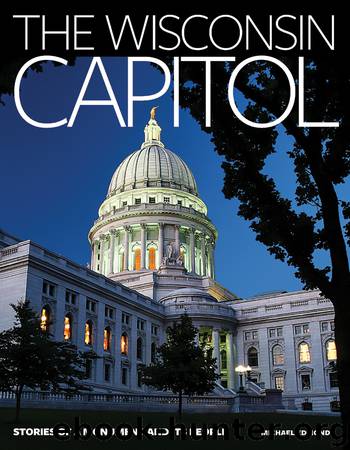The Wisconsin Capitol by Michael Edmonds

Author:Michael Edmonds
Language: eng
Format: epub
Publisher: Wisconsin Historical Society Press
Published: 2017-04-05T04:00:00+00:00
Former boxer Tommy Gibbons, Father Gordon, and Governor Fred Zimmerman at a Ho-Chunk ceremony in 1927
WHI IMAGE ID 84106
Governor Zimmerman’s adoption by the Ho-Chunk may have been a tourist stunt or a sincere appreciation for his interest in Indian causes. At the time, he was supporting preservation of ancient effigy mounds and a traditional Ho-Chunk village site at Frosts Woods, across Lake Monona from the Capitol. In a second ceremony there a few weeks later, the tribe named him a chief.
After taking part in the ceremony that summer night in the Dells, the governor was presented with a holy beaded pouch and a headdress. Zimmerman was humbled. “It makes me feel that I owe it to the Great Spirit to do all that I can for all my brethren,” he replied. “May we, as Americans, all of us, leave this impressive ceremony with one purpose, to carry the spirit and the truth and the honesty of these people out into our state and into our country.”
“The remainder of the evening was devoted to entertainment,” a reporter noted, “of which the governor’s dancing was not the least entertaining feature.”
By the end of the 1920s, the Capitol was severely overcrowded. Wisconsin’s population had grown to nearly three million people, and state offices expanded to meet increasing demands from residents. Progressive Republicans had passed laws regulating everything from child labor to food safety, which inspectors had to enforce. New technology played a role, too. For example, the invention of automobiles spawned an agency to issue drivers licenses, a State Highway Department to create safe roads, and an Oil Inspection Department to ensure reliable gasoline.
At the time, lawmakers worked in Madison for only a few months every other year; the rest of the time, the legislature was not in session. As soon as lawmakers left for their homes, the Capitol’s full-time employees surged out of their cramped offices to take up residence in senate and assembly committee and caucus rooms, or even in the official chambers. When the next legislative session approached, they would pack up their files and cram their furniture back into their assigned spaces for a few months.
While this biennial juggling act was underway in December 1928, the Capital Times sent a reporter to investigate working conditions in the Capitol. “There is one well-known official using a women’s lavatory for his office,” William Dawson found, “while his stenographer occupies a bathroom just around the corner.” Every basement corner, storage room, and corridor had been turned into office space. On the fourth floor, eighteen employees of one agency were crammed into a single room, and eleven staff of the Tax Commission worked in a blocked-off entryway. Temperatures reached 100 degrees in some places, ventilation and lighting were poor, and staff frequently became ill. “I am too sick to stand it longer,” one clerk told coworkers as she resigned. “Life is too short.”
These conditions prompted the construction of an office building two blocks away at 1 West Wilson Street, overlooking Lake Monona. The Highway Commission and Industrial Commission moved in when the building was completed in 1931.
Download
This site does not store any files on its server. We only index and link to content provided by other sites. Please contact the content providers to delete copyright contents if any and email us, we'll remove relevant links or contents immediately.
| Africa | Americas |
| Arctic & Antarctica | Asia |
| Australia & Oceania | Europe |
| Middle East | Russia |
| United States | World |
| Ancient Civilizations | Military |
| Historical Study & Educational Resources |
Cat's cradle by Kurt Vonnegut(14785)
Pimp by Iceberg Slim(13809)
Underground: A Human History of the Worlds Beneath Our Feet by Will Hunt(11850)
4 3 2 1: A Novel by Paul Auster(11822)
The Radium Girls by Kate Moore(11641)
Wiseguy by Nicholas Pileggi(5335)
American History Stories, Volume III (Yesterday's Classics) by Pratt Mara L(5141)
Perfect Rhythm by Jae(5083)
The Fire Next Time by James Baldwin(5034)
Paper Towns by Green John(4815)
Pale Blue Dot by Carl Sagan(4632)
A Higher Loyalty: Truth, Lies, and Leadership by James Comey(4567)
The Mayflower and the Pilgrims' New World by Nathaniel Philbrick(4288)
The Doomsday Machine by Daniel Ellsberg(4254)
Killers of the Flower Moon: The Osage Murders and the Birth of the FBI by David Grann(4198)
Too Much and Not the Mood by Durga Chew-Bose(4105)
The Sympathizer by Viet Thanh Nguyen(4100)
The Borden Murders by Sarah Miller(4033)
Sticky Fingers by Joe Hagan(3918)
